|

Winter 2005 (13.4)
Pages
36-39
Perspective - Nariman Narimanov
Early Years of Bolsheviks - Wrong Direction
by
Atakhan Pashayev
  The National Archives of Azerbaijan
was established by a decree in 1920 by Nariman Narimanov (1870-1925),
who was one of the leading personalities who helped usher the
Bolsheviks into power in Azerbaijan earlier that year. The National Archives of Azerbaijan
was established by a decree in 1920 by Nariman Narimanov (1870-1925),
who was one of the leading personalities who helped usher the
Bolsheviks into power in Azerbaijan earlier that year.
In December 2005, the National Archives celebrated its 85th Jubilee.
Though many of the documents from this turbulent period when
Bolsheviks took control of Baku [1920] have been lost, there
are others which have enabled historians to slowly piece together
the events that shaped those early years of Soviet Azerbaijan.
Atakhan Pashayev is one person who knows the archives extremely
well, having spent his entire professional career working there
since 1962. Despite the fact that Narimanov was instrumental
in getting the Soviet government set up in Azerbaijan, Pashayev
is convinced that Narimanov genuinely had Azerbaijan's interests
at heart.
He also is convinced that Narimanov's mysterious death was not
simply a heart attack but part of Stalin's plan to remove Nariman
from his position in Azerbaijan because he had directly contradicted
Stalin's policy and spoken openly about it. Nariman, according
to Pashayev, is one of the first in a long-line of Bolshevik
and Soviet leaders to disappear from the scene when he was no
longer useful to the system.
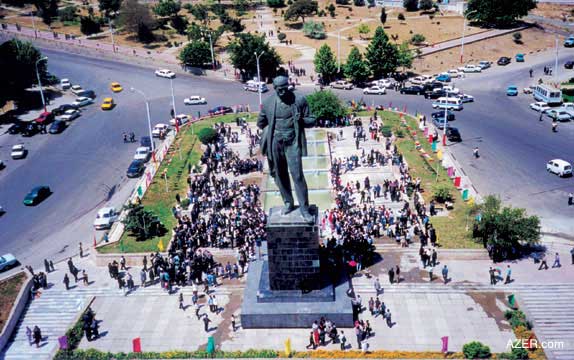
Above: The Narimanov statue in Baku was organized for
the occasion of Nariman Narimanov's 100th Jubilee (1970). The
statue was erected a few years later upon the insistence of Heydar
Aliyev, First Secretary of the Central Committee of the Azerbaijani
Communist Party. Narimanov's statue is one of few which has not
been pulled down after the collapse of the Soviet Union since
he was a leader involved in the early Bolshevik movement in Azerbaijan
(1920). Though Narimanov is a controversial figure, some historians
claim he really did have Azerbaijan's best interests at heart.
Photo: Khanlou.
I've come to the conclusion
from my extensive research in Azerbaijan's National Archives
that Nariman Narimanov really loved his people and his nation
very much. He was among those who helped to establish the Hummat
Party back at the beginning of the 20th century. Hummat was a
branch of the Russian Social Democratic Party that was established
by Muslims in Azerbaijan.
But after the 1917 October Revolution, the Bolsheviks issued
a decree concerning the rights of nations to determine their
own fate. Accordingly, any nation within the region of the territory
ruled by the former Czar of Russia could separate any time and
form its own national state. After this decree, Narimanov got
more involved with the Bolsheviks. At that time, the Soviet government
had already been formed in Russia, although it had not yet been
organized in the Caucasus.

Above: Painting of Nariman Narimanov in
1970 by Azerbaijani artist Ogtay Sadigzade, who was imprisoned
in labor camps in Central Asia for five years. Ogtay was charged
with being the son of an "Enemy of the People". His
father, a writer and intellectual, was falsely accused and then
arrested and executed. This painting is entitled: "The 1920s".
It hangs in the Home Museum of Nariman Narimanov in Baku. Photo:
Art by Ogtay Sadigzade. Corner: Statue of Narimanov. Photo: Blair.
Naturally, what interested Lenin the most was Baku's oil. He
didn't want to lose the fields that had been developed during
the Czar's period. Armenians were very active in this work. Stepan
Shaumyan had established close relations with Lenin. At the beginning
of 1918, Lenin appointed Shaumyan as Extraordinary Commissar
to the Caucasus. Shaumyan went to Tbilisi, as this was the center
of the former Caucasus Province. However, he soon was forced
to leave, and since Baku was one of the cities where democratic
movements and revolts were quite prevalent, Shaumyan came here.
Lenin's followers welcomed him.
In March 1918, the People's Commissariat in Baku was established
and Shaumyan was appointed as its Chairman. At that time Russia,
England and France together were fighting against Germany, Austria,
Hungary and Turkey. The Caucasus front had been opened from Eastern
Anatolia, and Armenians comprised the majority of soldiers fighting
there on behalf of the Russians.
Massacre of 1918
After the Bolshevik Revolution in Russia (1917), Russia gradually
pulled out of the war, and the soldiers who had been defending
the Caucasus started to return home. At that time, the Armenian
soldiers held onto their guns and, in fact, bought additional
guns from the Russian soldiers as well. The Russian soldiers
had to pass through Baku en route back home, and Armenians frightened
them by saying that Muslims were barbarians and that they might
get killed in Baku.
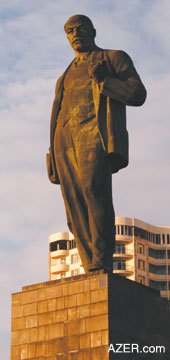  It
was for this reason that authorities in Baku were demanding that
the Russian soldiers be disarmed while passing through Baku.
But Shaumyan did not allow this to happen. Instead, he further
armed the Armenian Dashnaks. Narimanov was the Commissar of Communal
Economy at that time [1918]. So talks were carried out between
the Musavat party (Azerbaijanis who wanted to rid themselves
of rule of the czar) and the Dashnak party (an Armenian revolutionary
group). Despite these talks, Shaumyan did not allow disarmament
to take place. It
was for this reason that authorities in Baku were demanding that
the Russian soldiers be disarmed while passing through Baku.
But Shaumyan did not allow this to happen. Instead, he further
armed the Armenian Dashnaks. Narimanov was the Commissar of Communal
Economy at that time [1918]. So talks were carried out between
the Musavat party (Azerbaijanis who wanted to rid themselves
of rule of the czar) and the Dashnak party (an Armenian revolutionary
group). Despite these talks, Shaumyan did not allow disarmament
to take place.
A great tragedy followed when Armenians and Russians organized
a massacre in Baku on March 18-21, 1918. Those days were deliberately
chosen because this is usually the most joyous and happy holiday
of the year - Novruz [Rite of Spring]. Some sources say that
about 10,000 people were killed, while others suggest the figure
to be as high as 15,000. This slaughter in the streets lasted
three days - March 18-21 by the old calendar (or March 30-April
1 by the new calendar).
During this massacre, they burned down the most ornate example
of Oil Baron architecture in the entire city - Musa Naghiyev's
palatial mansion, which he had dedicated to the memory of his
son Ismayil and which was being used to house the Philanthropic
Society. Today this building on Istiglaliyyat Street serves as
the Presidium of the Academy of Sciences. Nearby stood the editorial
office of Kaspi newspaper. They burned them as well. They also
did severe damage to the Taza Pir mosque and to the Metropol
Hotel, which has since been converted into the Nizami Literature
Museum. It's interesting to note that about 70-80 percent of
the people working at the People's Commissariat in 1918 in Azerbaijan
were Armenians. Nariman Narimanov, Mashadi Azizbeyov and Heydar
Vazirov were the only Azerbaijanis in this group.
On May 28, 1918, the Azerbaijan government was first established
in Tbilisi [Georgia]. On June 16, they moved to the city of Ganja
[Azerbaijan]. Lenin sent military support to Shaumyan, which
supported their attack against Ganja in the north central region
of Azerbaijan. The army succeeded in moving up into the regions
of Goychay and even Kurdamir.
On June 4, 1918, Mammad Amin Rasulzade and Mammad Hasan Hajinski
signed a contract with Turkey on behalf of the Azerbaijan Democratic
Republic [ADR]. Hajinski was serving as the Minister of Foreign
Affairs at the time. One of the major agreements of that treaty
was that the Ottoman Empire (in other words, Turkey), could provide
military assistance if Azerbaijan needed it.
Already by the second half of June, Turkish troops had passed
through the Gazakh region (in northern Azerbaijan) and had entered
Ganja. Volunteers in Azerbaijan along with a brigade of officers
previously serving in the Czar's army, joined the Turkish troops,
and together they succeeded to push back the troops of the People's
Commissariat. At this time a major argument broke out between
Narimanov and Shaumyan. Viewpoints differ as to what actually
happened. The result was that Narimanov had a stroke and was
sent to Astrakhan [Russia] for treatment.
Narimanov was about 50 years old at the time. The Tatars [a Turkic
group living along the Volga River] considered him their leader
and held him in high regard. He was greatly respected among the
Muslims. At that time Lenin was wondering who to appoint to establish
relations with the Eastern nations, such as Iran and Afghanistan.
That's when he chose Narimanov. At that time, Stalin was the
Commissar on National Issues.
  Narimanov and Lenin Narimanov and Lenin
Narimanov was called to St. Petersburg and appointed as the Chair
of the Eastern Division. That's when they started to use him
to undermine the activities of the independent-minded ADR government.
He sent open letters to Nasib Bey Nasibbeyli, who was the Chairman
of ADR government. They are all available and have been published.
Left: Narimanov's Statue in recent snow storm
in January 2006. Photo: Elman Gurbanov.
The Bolsheviks actively used Narimanov, as well as others in
Azerbaijan in their efforts to overthrow the fledgling independence
movement in Azerbaijan (May 1918 to April 1920).
After succeeding, they appointed Narimanov as the Chair of the
Committee of People's Commissariat. He would return to Azerbaijan
as the Chairman of Revolution Committee.
When Narimanov met with Lenin to discuss these issues, he explained
that when they would establish a new government in Azerbaijan,
it should consist of only Azerbaijanis so that the people would
trust them.
That's why 80-90 percent of the leaders of the Azerbaijan Revolution
Committee of the People's Commissariat consisted of Azerbaijanis
when Narimanov returned to Azerbaijan to set up the Soviet government
here.
But Lenin was very shrewd. He wanted control over Azerbaijan.
The documents indicate that Commissar Tamashevski and Secretary
Gabridze had both signed this document. They were the ones who,
in fact, were overseeing all developments in Azerbaijan.
When Lenin established the Communist Party, he based its policy
on international principles, not national ones. In February 1920,
the Baku Bolsheviks, the Adalat Party and the Ahrar Party of
Iran joined together to establish the Azerbaijan Communist Party.
Lenin sent Kalinsky to be Secretary of the Party, and then in
1922, assigned the position to Kirov. These individuals had strict
oversight over the Committee of People's Commissars.
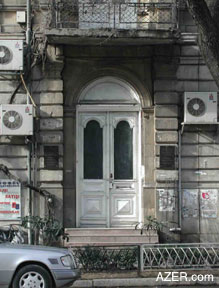 |
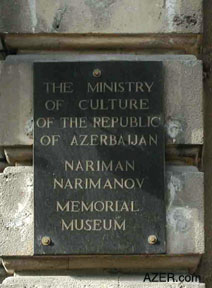 |
Above (Left): Entrance doorway to the Narimanov
Home Museum at 30 Istiglaliyyat Street. The museum is on the
second floor and if they were given power, they would kill all
non-Azerbaijanis. Right: Plaque
at the street level of Narimanov Home Museum in English. The
plaque on the left hand side of the entrance is in Azeri. Photos:
Narimanov Museum-Ulviyya Mammadova.
On April 27, 1920, eleven days after the establishment of the
Soviet government, Lenin appointed Serebrovsky to Azneft [the
major oil-producing company]. Lenin congratulated Azerbaijan
on the formation of an independent Azerbaijan Soviet Socialist
Republic; however, the documents signed by Lenin and Stalin gave
Serebrovsky complete authority over the oil industry in Azerbaijan
and demanded that everybody - both military and civilians - follow
Serebrovsky's command.
During those 23 months when the independent Azerbaijan functioned
[May 1918 to April 1920], Azerbaijan experienced so many difficulties.
British Role
On November 17, 1918,
British military leader Thompson invaded Baku. They banned the
ADR at that time. Armenian and Russian Society members met Thomson
in Anzali, the most important port in the Caspian, for Iran telling
Thomson that Azerbaijanis were barbarians
After Thomson arrived in Baku on November 17, 1918, long discussions
were carried out with Fatali Khan Khoyski (1878-1920) who served
as the first Prime Minister of the Azerbaijan Democratic Republic.
Thomson insisted that the government consist of people from various
nationalities - Azerbaijanis as well as others. When they discussed
these issues in the Azerbaijan National Council, they didn't
even take time for translations. For example, sometimes the documents
were written in Russian, but the meetings were held in Azeri.
The negotiations between Thomson and the ADR lasted from November
17 until December 9. Finally, Thomson agreed to the establishment
of the Azerbaijan Parliament.
Actually, the Party was more important than the government itself.
Every decision made by the Party had to be fulfilled immediately
by the government. That's why Narimanov realized that he had
been deceived. In reality, it was Kirov and Serebrovsky who were
leading the government. When Serebrovsky wrote a letter to Nariman
Narimanov, he would copy the same letter to Kirov so that he
could oversee Narimanov's activities.
Despite the fact that Armenians had killed so many Azerbaijanis
while the ADR was in power in 1918-1920, Kirov was able to establish
an Armenian mafia here, which included the likes of Mirzoyan,
Mikoyan, Sarkis and others. In turn, these figures started to
pull Narimanov into a trap. They were the ones who reached the
agreement with Lenin about giving less than 10 percent of the
oil to Azerbaijan while making sure that the rest was sent to
Russia.
 |
 |
Above (Left): Narimanov's bedroom on display in the
museum. Right: Living room of the museum. Note Narimanov's
tar on the table. Photos: Narimanov Museum - Ulviyya Mammadova.
We have documents from Azneft. There were so many arguments about
this issue. At the 21st Congress, Azerbaijanis were questioning
how it could be that oil, which was being produced in Azerbaijan
was cheaper to buy in Georgia and Armenia than in Azerbaijan.
By December 1922 when the Soviet authority was well established
in Azerbaijan, their primary goal was to gain control over everything
and then to remove Narimanov.
There were four chairmen of the USSR Central Executive Committee.
They represented the Caucasus, Russia, Ukraine and Belorussia
[Belarus]. Each was supposed to lead the Committee in turn. Narimanov
was one of these chairmen, but he understood the trap that they
had set for him, especially after the death of Lenin. He wrote
an Open Letter to Stalin and the Central Committee about their
national policy in provinces.
Narimanov wrote that, unfortunately, Stalin didn't believe us
Muslims and had given the power to the Orjonokidzes, Mirzoyans
and Mikoyans.
Narimanov's Death
I'm mentioning these facts because it explains the reason of
Narimanov's death. There was always a method to Stalin's approach.
It was not just Narimanov that he killed by this method. He later
also killed Orjonikidze, Kirov and others the same way. He would
organize the deaths of such people, either by suicide or by some
other way that appeared very natural, and then after their death,
he would organize solemn funerals in their honor. The general
public, then, would not be suspicious of any foul play.
Nobody seems to know exactly how Stalin organized Narimanov's
death. In the memoir of one of his relatives, it says that he
came home one day, had some food and then left. About an hour,
or an hour and a half later, the family was notified that Narimanov
had passed away. They say that a cleaning person noticed that
he was feeling bad and notified someone and they took him away.
Narimanov was one of the first of Stalin's victims, and one of
the first to be buried at the Kremlin. His gravestone is still
there behind the Lenin Mausoleum where they used to bury the
most famous personalities. Kirov and Orjanikidze are also buried
there.
After Narimanov died, the government announced a  three-day
period of mourning. Hundreds of thousands of people participated
in his funeral - just as if he had died naturally. Narimanov
was only 55 years old at the time. People hold different opinions
about Narimanov. Some people, especially members of the National
Front, which came to power in Azerbaijan at the beginning of
1990s, denounce him as an "Enemy of the People". For
example, Narimanov insisted that Azerbaijan's happiness was connected
with Russia. That is inscribed on Narimanov's statue. The National
Front criticized him for everything. Some people considered him
to be a Nationalist, but that isn't right either. Simply, Narimanov
loved his nation. three-day
period of mourning. Hundreds of thousands of people participated
in his funeral - just as if he had died naturally. Narimanov
was only 55 years old at the time. People hold different opinions
about Narimanov. Some people, especially members of the National
Front, which came to power in Azerbaijan at the beginning of
1990s, denounce him as an "Enemy of the People". For
example, Narimanov insisted that Azerbaijan's happiness was connected
with Russia. That is inscribed on Narimanov's statue. The National
Front criticized him for everything. Some people considered him
to be a Nationalist, but that isn't right either. Simply, Narimanov
loved his nation.
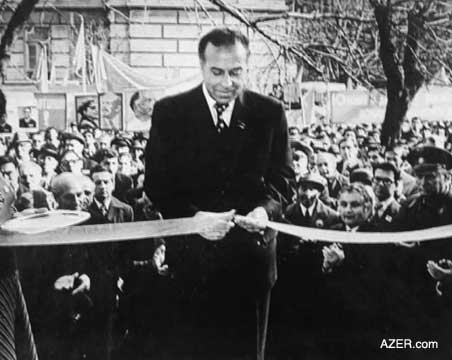
Above:
Heydar Aliyev, as First
Secretary of the Central Committee of the Azerbaijani Communist
Party, was instrumental at the opening ceremony of the Narimanov
Memorial Home Museum in 1977. Photo: National archives of Azerbaijan.
Both Georgians and Armenians
wrote many things against Narimanov. Heydar Aliyev issued a decree
to celebrate his 100th Jubilee [1970] and to erect a statue in
his memory. The statue was designed so that it could be seen
from all parts of the city, just as Kirov's monument, which overlooked
Baku from the highest vantage point. But Levon Shaumyan, son
of Stepan Shaumyan, who was the Editor of the Soviet Encyclopedia
at that time, offered extreme resistance to the idea.
Because of the ensuing arguments about the statue, Narimanov's
Jubilee was delayed for more than two years. His 100th jubilee
was actually celebrated in 1970, but the statue was not erected
until 1973 or 1974 and only because of the strong will of Heydar
Aliyev. However, those who opposed the idea succeeded in having
the pedestal designed lower than originally planned. Usually
the pedestal is at least twice as high as the statue itself.
Narimanov's stand is much shorter. However, unlike all the other
leaders of the Bolshevik movement - Stalin, Kirov, and even Lenin,
the statue of Narimanov still stands. It has not been dismantled
as were others, especially after the Soviet Union collapsed in
late 1991.
Atakhan Pashayev is Director of the National Archives of Azerbaijan,
which just celebrated its 85th Jubilee in December 2005. He has
been working there since 1962 and has held the position of Director
since 1984.
Back to Index AI 13.4 (Winter
2005)
AI Home
| Search | Magazine
Choice
| Topics
| AI Store | Contact us
Other Web sites
created by Azerbaijan International
AZgallery.org | AZERI.org | HAJIBEYOV.com
|










